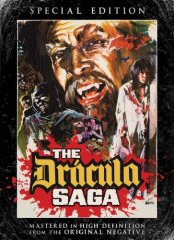
With Werewolf's Shadow, one of the pinnacles of Spanish gothic horror, director Leon Kilmovsky inspired an entire generation of filmmakers to embrace Spain's bloody past and turn the raw stuff of dread into the fantastical dreamscapes of cinema. Along with Paul Naschy, and his protégé Carlos Aured, Kilmovsky injected eldritch supernatural folklore and archetypes with ghostly atmosphere and surprising believability. While some of his most memorable films were crafted with the help of Naschy, such as Vengeance of the Zombies (also available from BCI) and Dr. Jeckyll and the Werewolf, the shamefully forgotten director also made several minor macabre masterworks on his own. Favouring traditional occult topics, Kilmovsky instilled tired clichés with new life, putting a bounce in the werewolf's step and giving new fangs to the undead. His monsters are frightening and sympathetic in the Universal tradition, but not so one sided so as to be banal. We have sympathy for these tortured souls but the tone of these films, and their modern attitudes, enliven the standard monster movie formula with moral ambiguity. The Dracula Saga, written by Emilio Martinez, is a perfect example of the director's instinctive feel for dread and wonder. His ability to make monsters more humane while simultaneously revealing character's darker flaws, makes this film as much a character study as it is a deliriously surreal monster mash.
When Berta and her husband Hans travel to her Grandfather's estate to see her estranged family, she unwittingly places herself in a web of deceit, bloodlust, and fiendish family ties. Along the way to the ancestral estate, she learns that women are being drained of blood in the village, crimes that some blame on Dracula, her Grandfather. Incredibly she continues to ignore the signs that her family is undead, despite the fact that she never sees them until sunset, their pale skin tones, etc. Her hubby has no qualms either, bedding every female he can find in the castle! Rather large red herrings lead to the discovery that 'Grandpa' harbours sinister plans of Berta's baby, and anticipates that the young fellow, once born, will be a chip off the old block. A descent into depravity, family betrayal, and emotional repulsion follows, all soaked in grand gothic shadows.
The Dracula Saga is an eccentric, unique twist on the Dracula character and vampire legend. The plot, while uneven and often ridiculous, has fun merging pulp shocks with a broodingly romantic mood, making for evocative visual flair as well as psychological tension. Neither too serious to diminish its escapist palate nor too pulpy to downplay its more tragic and horrifying moments, Klimovsky balances mayhem and character development. Scantily clad vampire women, lurking shadows, moodily lit interiors, and morose performances present a world decayed and desperate to be reborn, which, in feeling, is similar to one of the chief emotions present in Stoker's novel. Themes of isolation, family ties, and hunger are enlivened by wonderfully creepy dream sequences and the Count's saddened yet determined character. Berta isn't entirely likeable, but she captures the terror and soul-crushing despair of alienation. Many will be quick to complain that there isn't enough violence. This is to the film's good, for cliché vampire attacks are exchanged for scenes of numbing dread, such as the focus on Berta's troubled childbirth and the more subtle (if no less threatening) terrors of dysfunctional families. This is in direct opposition to modern audience's hunger for explosive fire-tits-and-slaughter action. Because Kilmovsky slowly builds up to the final nightmare, it's twice as potent, and both the story and direction, while strained on coincidence, is a unique and phantasmagorical addition to the vampire mythos.
BCI takes great pride in their Spanish line. The Dracula Sage has been re-mastered in high definition from original negative material, and is presented in Fullscreen. Complete and uncut, the picture quality is clean and vibrant, with skin tones realistic and blacks solid. There are two audio tracks, one in English Mono, the other Castilian Mono (with additional English subs). As always, I prefer the original language, as it gives you a more organic, truthful experience. Both tracks are clean and audible.
Extras are nowhere as comprehensive as for other titles in the series. We get an Alternate Clothed Sequence for the original Spanish release, a Spanish Credit Sequence, and, most enjoyable, a collection of Spanish Horror Collection trailers.
Review by William P. Simmons
| Released by Bci/Eclipse |
| Region 1 - NTSC |
| Not Rated |
| Extras : |
| see main review |